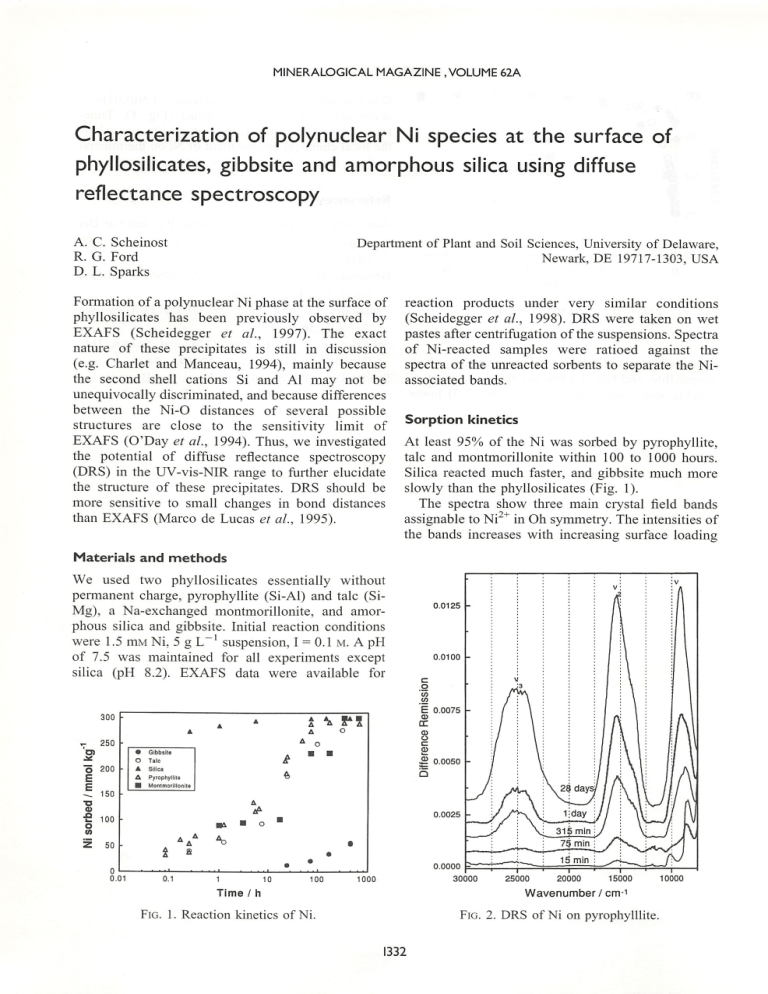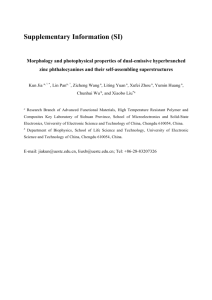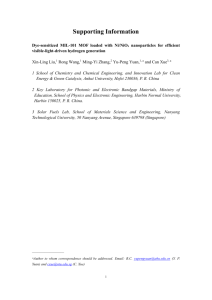Characterization of polynuclear Ni species at the surface of
advertisement

MINERALOGICAL MAGAZINE .VOLUME 62A Characterization of polynuclear Ni species at the surface of phyllosilicates, gibbsite and amorphous silica using diffuse reflectance spectroscopy A. C. Scheinost Department of Plant and Soil Sciences, University of Delaware, R. G. Ford Newark, DE 19717-1303, USA D. L. Sparks Formation of a polynuclear Ni phase at the surface of phyllosilicates has been previously observed by EXAFS (Scheidegger et al., 1997). The exact nature of these precipitates is still in discussion (e.g. Charlet and Manceau, 1994), mainly because the second shell cations Si and Al may not be reaction products under very similar conditions (Scheidegger et al., 1998). DRS were taken on wet pastes after centrifugation of the suspensions. Spectra of Ni-reacted samples were ratioed against the spectra of the unreacted sorbents to separate the Niassociated bands. unequivocally discriminated, and because differences between the Ni-0 distances of several possible structures are close to the sensitivity limit of EXAFS (O'Day et al., 1994). Thus, we investigated Sorption kinetics the potential of diffuse reflectance spectroscopy talc and montmorillonite within 100 to 1000 hours. (DRS) in the UV-vis-NIR range to further elucidate the structure of these precipitates. DRS should be more sensitive to small changes in bond distances than EXAFS (Marco de Lucas et al, 1995). Silica reacted much faster, and gibbsite much more slowly than the phyllosilicates (Fig. 1). The spectra show three main crystal field bands At least 95% of the Ni was sorbed by pyrophyllite, assignable to Ni^^ in Oh symmetry. The intensities of the bands increases with increasing surface loading Materials and methods We used two phyllosilicates essentially without permanent charge, pyrophyllite (Si-Al) and talc (SiMg), a Na-exchanged montmorillonite, and amor phous silica and gibbsite. Initial reaction conditions were 1.5 mM Ni, 5 g L~' suspension, I = 0.1 m. A pH of 7.5 was maintained for all experiments except silica (pH 8.2). EXAFS data were available for . 9 E ( £ ' Q 25000 20000 15000 Wavenumber/cm-1 Fig. 2. DRS of Ni on pyrophylllite. Fig. 1. Reaction kinetics of Ni. 1332 GOLDSCHMIDT CONFERENCE TOULOUSE 1998 Ni sorbed / mmol kg Fig. 3. Increase of V2 peak height as a function of surface loading. as shown for the spectra of pyrophyllite (Fig. 2). The band positions remain, however, essentially constant. The height of V3 is curvilinearly related to the sorbed Ni (Fig. 3). 30000 Characterization of surface species 25000 20000 15000 10000 5000 Wavenumber/cm"' In Fig. 4, spectra of Ni sorbed on the different minerals are shown (t = 7days, peak height of V2 normalized). The crystal field splitting energy, 10 Dq Fig. 4. Nomialized DRS of Ni surface species after 7 days. (= Vi), increases from 9097 cm"' (montmorillonite) to 9213 cm"' (gibbsite), indicating a decrease in NiO bond distances. The lODq of NiCOs (8390 cm"'), an amorphous Ni silicate (8460 cm^'), Ni(0H)2 (8787 cm"') (Fig. 5) and the Ni-silicate kerolite (8950 cm"') (Manceau and Calas, 1985) are lower in energy than the surface species, i.e. have larger bond distances. Synthetic Ni/ A1 hydrotalcite has a similar lODq of 9207 cm"', and a similar V2 of 15390 cm"'. The position of V3 is, however, at a lower energy than the V3 of Nipyrophyllite. Conclusion DRS is as sensitive as EXAFS to probe low concentrations of sorbed Ni. The 10 Dq of Ni surface species is similar to that of hydrotalcite structures, and significantly different from the lODq of Ni silicates, NiCOs and Ni(0H)2. There are, however, differences between the sorbents, indicating differences in Ni-0 bond lengths and bond covalency. We will investigate the spectra of synthetic Ni compounds at various stages of crystallinity to better understand the spectra of surface complexes. 1333 30000 25000 20000 15000 10000 5000 Wa v e n u m b e r / c m - 1 Fig. 5. Normalized DRS of reference compounds.





